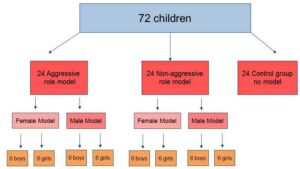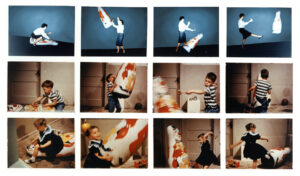In 1961, researchers Albert Bandura, Dorothea Ross and Sheila A. Ross published an article in the Journal of Abnormal and Social Psychology titled: “Transmission of Aggression through Imitation of Aggressive Models”. This study helped many begin to understand one of the many aspects of aggression.
In this famous study, the researchers had 36 boys and 36 girls who were in the Stanford University Nursery. These children were between the ages of three to six years. In the experimental design, the children were placed into different groups. Below is a diagram of the groups:

As you can see, the children were either placed in the control group with no adult model, or one of the groups with an aggressive or non-aggressive model. The children placed with the aggressive model watched an adult, either male or female, in a room with toys. In this scenario, the adult was aggressive towards a specific toy, Bobo Doll. The adults would hit Bobo with a hammer, throw it in the air, and say hostile comments toward the inflated clown. The group that had a non-aggressive model, either male or female, watched the adult play with the toys quietly, while they ignored the Bobo Doll. The control group did not have a model to witness either aggressive or non-aggressive behaviors.
After the children had watched the video of the adult’s behavior or not watched for the control group, each of the children were taken individually to a room with appealing toys. However, as soon as each child started to play, the experimenter would enter and say that they needed to use the toys for other children. This part of the experiment was meant to increase aggression in all groups.
Lastly, the children were taken to a similar room that they had witnessed the adult model’s in, depending on their group. The room had both non-aggressive and aggressive toys for the children to play with for 20 minutes, while being observed.

The children who had witnessed an aggressive adult model were significantly more imitative and aggressive that those children who were in the control group or did not witness an aggressive model. This study went on to help support Bandura’s Social Learning Theory, which explains that children learn through watching others, including their caregivers. To hear and see some of the results yourself, watch this video:
For more information or additional resources, check these out:
- Bandura, A., Ross, D. & Ross, S.A. (1961). Transmission of aggression through imitation of aggressive models. Journal of Abnormal and Social Psychology, 63, 575-82.
- http://www.simplypsychology.org/bobo-doll.html
- http://psychclassics.yorku.ca/Bandura/bobo.htm